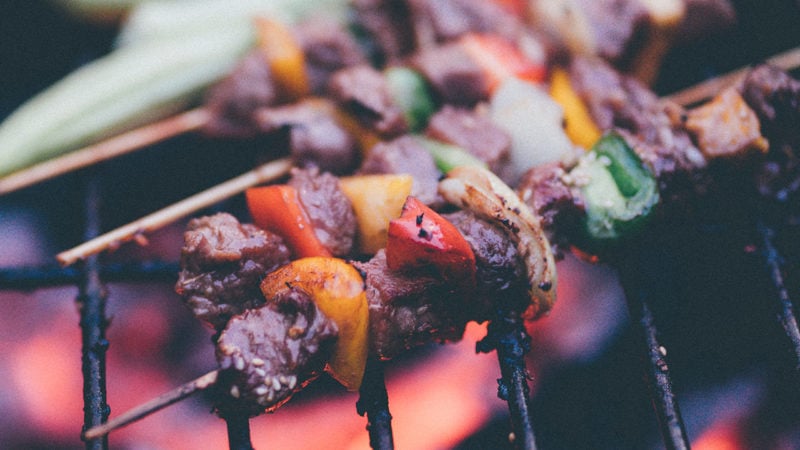Last Updated on February 5, 2024
Kebabs—meat, usually beef—cooked on a skewer, often with vegetables, have a long and truly intercontinental history. As an English culinary term, according to The Oxford Companion for Food, it is often used with the term shish or sis to denote being grilled on a skewer. In this context, the term shish kebob has also long been used for this delicious meal.
Somewhat confusingly, kebob is also part of the lexicon of beef cut terminology, denoting larger cubed pieces of beef with little fat that come from the “major primal (ideally chuck, loin, or round) exclusive of any shank, heel, neck, and stew meat.” As the National Cattlemen’s Beef Association and Cattleman’s Beef Board website explains, the term is derived from the Turkish word, sis kebap, which refers to meat served on a skewer.
Confused yet? Is it kebabs or kebobs?
Let us help explain how an evolution in food language of this manner occurs.
From the Middle East to California Grills, the Journey of Skewered Meat
Some version of kebab exists in almost every food culture in the world.
It is a staple, and most common in Asia, parts of Africa, the Middle East, and Eastern Europe, the Caucuses in particular. In the West, most notably Europe and the U.S., it has become popular in the form of shish kabob—or shish kebab—and doner kebab. The global expansion of this dish can be traced to Muslim influence beyond the Middle East and into the culinary world.
The name of the skewered meal derives from a Middle Ages Arabian word, kabab, which was the term for fried meat, according to The Oxford Food Companion. Interestingly, the roasting of small pieces of meat on a skewer is thought to have developed due to the more urban community structure of the Middle East and Asia—as opposed to the agrarian-nature of Europe. While meat was often cooked in large cuts in Europe due to domesticated, pastured animals and the ample supply of cooking fuel from the abundance of wood, it is believed that populations in the Middle East relied on butchers and had to be far more economic when burning natural fuels, due to the lack of firewood. Thus, they had to devise ways to cook more minimally-sized cuts of meat over smaller fires.
As the popularity of the cooking style grew beyond the Middle East, the idea of the old kabab evolved. In the Caucasus, it became known as shashlik, which eventually made its way onto the plates of many a Russian household. When it reached Indonesia along with Islam, the beef or chicken on a skewer was coated with peanut sauce and given the moniker, satay. In Turkey, it gained the currently popular moniker shish kabab, where the method used in the Ottoman Empire is revealed through the meaning of shish, or sis, which is the word for sword, and kabab, meaning lamb, or meat in general.
Lastly, when the Turkish influence hit the Peloponnesian, the Greeks began supplementing the small cuts of grilled meat on a skewer—most commonly lamb—by adding vegetables such as peppers and onions. This is the form that most American think of when kebab is mentioned, which is as popular a dish as ever on grills across the country.
Also a Cut of Beef?
If the name confusion between shish kebabs and kebobs isn’t enough, the U.S. meat industry went ahead and gave the moniker “kebob” to certain large cube-shaped cuts of beef. The cuts, which are larger than stew meat and often uniform in shape, are great for making a kebab, however, the size of the beef is quite larger than its Eastern cuisine namesake.
In fact, ButcherBox includes sirloin tip kebobs in some of our monthly boxes.
Our Head Chef, Yankel Polak, is a big fan of the cut. “Sirloin tips, in my opinion, are some of the best pieces of the sirloin,” he says. “There are plenty of delicious steaks and roasts cut from the sirloin, picanha, bavette, and tri-tip among them. But the sirloin tip kebobs are basically the scraps, the ends, the misshapen pieces, everything the butcher cuts off to make the tri-tip perfectly shaped, to make sure the picanha fits in the packaging, to get those perfect little bavette steaks.”
Which is a good thing, as Chef Yankel explains, “Basically, they’re a bonus. You get all the flavor and tenderness of the sirloin, in tiny bite-size pieces.”
The size of sirloin kebobs makes them perfect for absorbing flavors. “Because they are cut small, they have more surface area and are terrific marinated,” Chef Yankel says. “I love them skewered and grilled or tossed into a pan as the beginning of a delicious stir-fry.”
And while the story of the kebab is a bit circuitous, winding through a multitude of Asian and Middle Eastern traditions, it is pretty straightforward that beef skewered and grilled — or even cubes of beef marinated and tossed in a frying pan — is a delicious meal wherever in the world you may be.
Dennis Keohane is a writer, editor, and former Editorial Director for ButcherBox with a passion for storytelling and food. Combining his love for high-quality ingredients with engaging narratives, he crafts content that inspires home cooks to explore new flavors, techniques, and the joy of cooking.



